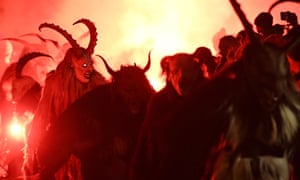Police record rising violence and drunkenness in relation to traditional folkloric festivities

Goat-horned half-demons with scraggy coats of fur, lolling tongues and threatening bundles of birch branches are no ones idea of a welcome guest on a winters night.
In Austria, however, the figure of the Krampus has been part of pre-Christmas folklore for centuries, with men in costumes roaming the streets to scare children and grownups from the end of November to the middle of December.
Yet in recent years the Krampus has developed to become an altogether very modern bogeyman, with a rising number of complaints about the demons acting in a drunkenly and disorderly fashion once they have donned their fearsome masks.
In Carinthia, police recorded a number of violent incidents this year in the run-up to the official Krampus day on 5 December, with one person being hit in the face with a birch and an 11-year-old child being left with bloody cut on their thigh.
In Klagenfurt, in Carinthia, the fire brigade complained that two of firefighters were set upon and beaten by a group of Krampuses, while in Salzburg last Sunday police were called out to deal with a number of drunken devils in the city centre.
A video of Thursdays Krampus run in Sterzing in South Tyrol, on the Italian side of the border, shows spectators fleeing in panic as a group of devils start to beat and kick a person lying on the ground.

In the town of in Lower Austria, a man dressed as a Percht, an Alpine pagan goddess, sustained severe neck injuries when a spectator yanked his mask by the horns.
In Schwoich in the Tyrol region, three Krampuses set their costumes on fire and suffered burns after accidentally setting off a box of fireworks.
According to Peter Wiesflecker, a historian of Austrian culture and customs, the spike in the number of complaints can be explained by how the cult of the Krampus has evolved into a mass spectacle.
In its original form, Wiesflecker argues, Krampus was not so much a standalone devil figure but a domesticated sidekick of Sankt Nikolaus, the Father Christmas-like character who gifts German and Austrian children with presents on 6 December.
In the 19th century, evil Krampus spirits began to accompany Sankt Nikolaus impersonators on home visits and would sometimes cross the threshold to scare children, but their anarchic energy was usually restrained and controlled by the benign man with the bushy white beard.
Fuelled by political support for distinctly Austrian folk customs, Krampus began to emancipate from his master in the late 20th century, and in recent years the appetite for large-scale Krampus runs has grown across Austria: at an event Salzburg on 23 November this year, about 1,000 goat-demons roamed the streets of the city.
Attempts to impose order on the chaos by assigning each Krampus with a starting number and setting up barriers between the evil spirits and spectators have not always been successful. An alcohol ban has also been difficult to enforce.
If large group of young men in masks roamed the streets on any other night of the year, the police would be called out in an instant, said Wiesflecker. In an anonymous collective, we are always more likely to overstep our boundaries.
Even smaller, more traditional Krampus associations have begun to enforce a codex that devil-impersonators are advised to follow. Krampus is meant to make spectators skin crawl with his appearance and movement not cause fear or even panic, state the guidelines issued by the Krampus association in the municipality of Anif, in Salzburg state.
The Anif Krampuses, which wear traditional wooden masks with bells, are advised never to hit spectators with their bundles of birch branches and cows tails, but only lightly brush them. The consumption of alcohol is forbidden until the mask is off. There is even a Krampus-free zone where children can escape when they get too scared.
The aim of the Krampus is not to hurt people, said Aleksander Andonov, who heads the Anif Krampus Association. On the contrary: we want to take away their fear. In the end, good always wins over evil.
Original Article : HERE ;
from MetNews https://metnews.pw/austria-struggles-with-marauding-krampus-demons-gone-rogue/
No comments:
Post a Comment